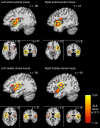Basic taste processing recruits bilateral anteroventral and middle dorsal insulae: An activation likelihood estimation meta-analysis of fMRI studies
- PMID: 28413706
- PMCID: PMC5390838
- DOI: 10.1002/brb3.655
Basic taste processing recruits bilateral anteroventral and middle dorsal insulae: An activation likelihood estimation meta-analysis of fMRI studies
Abstract
Background and purpose: Numerous task-based functional magnetic resonance imaging (fMRI) studies have reported the locations of basic taste representations in the human brain, but they usually employed a limited number of subjects (<20) with different methodologies and stimuli. Moreover, the reported brain regions were sometimes inconsistent. Thus, we aimed at performing a meta-analysis of the published data to identify locations consistently activated across studies, and performed a connectivity analysis to reveal how these taste processing regions connect with other brain regions.
Materials and methods: A meta-analysis was performed based on 34 experiments, with 238 total participants in 16 studies, to establish the activation likelihood estimation (ALE) of taste-mediated regional activation. Meta-analytic connectivity modeling (MACM) and data stored in BrainMap database were employed to reveal the functional connectivity of the regions identified by ALE with other brain regions, across all types of experiments that caused activation among healthy subjects.
Results: ALE identified nine activated clusters in bilateral anteroventral and middle dorsal insulae, bilateral thalamus and caudate, bilateral pre-/postcentral gyrus, and right hippocampus. The concurrence between studies was moderate, with at best 38% of experiments contributed to the significant clusters activated by taste stimulation. Sweet taste was the predominant contributing taste. MACM revealed that at least 50% of the nine clusters coactivated with the middle cingulate cortex, medial frontal gyrus, inferior parietal lobule, and putamen.
Conclusion: Results suggested that fMRI studies have reported reproducible patterns of activations across studies. The basic taste stimulations resulted in activations in a mostly bilateral network. Moreover, they were connected with cognitive and emotional relevant brain regions.
Keywords: connectivity; functional magnetic resonance imaging; insula; meta‐analysis; neuroimaging; taste.
Figures


References
Publication types
MeSH terms
LinkOut - more resources
Full Text Sources
Other Literature Sources
Medical

